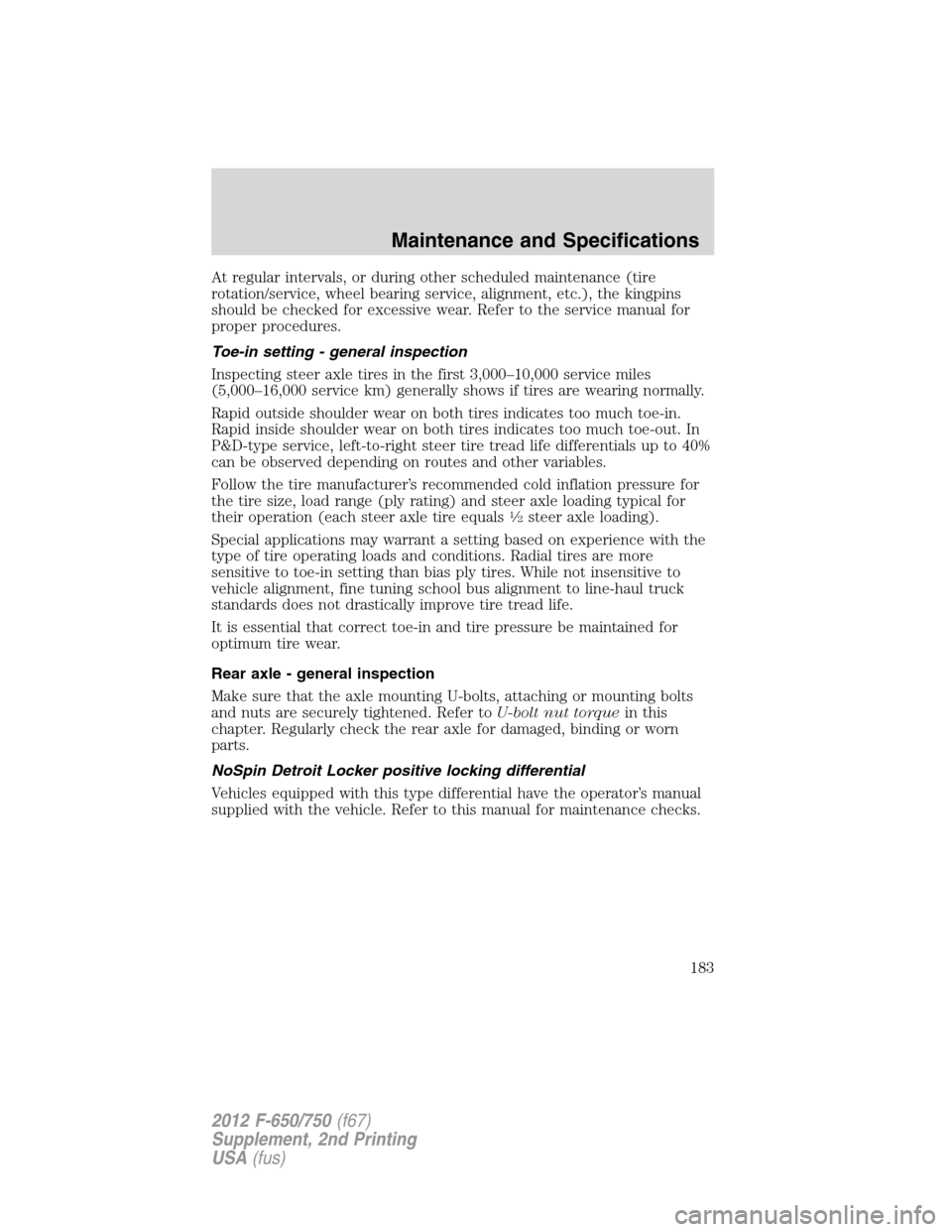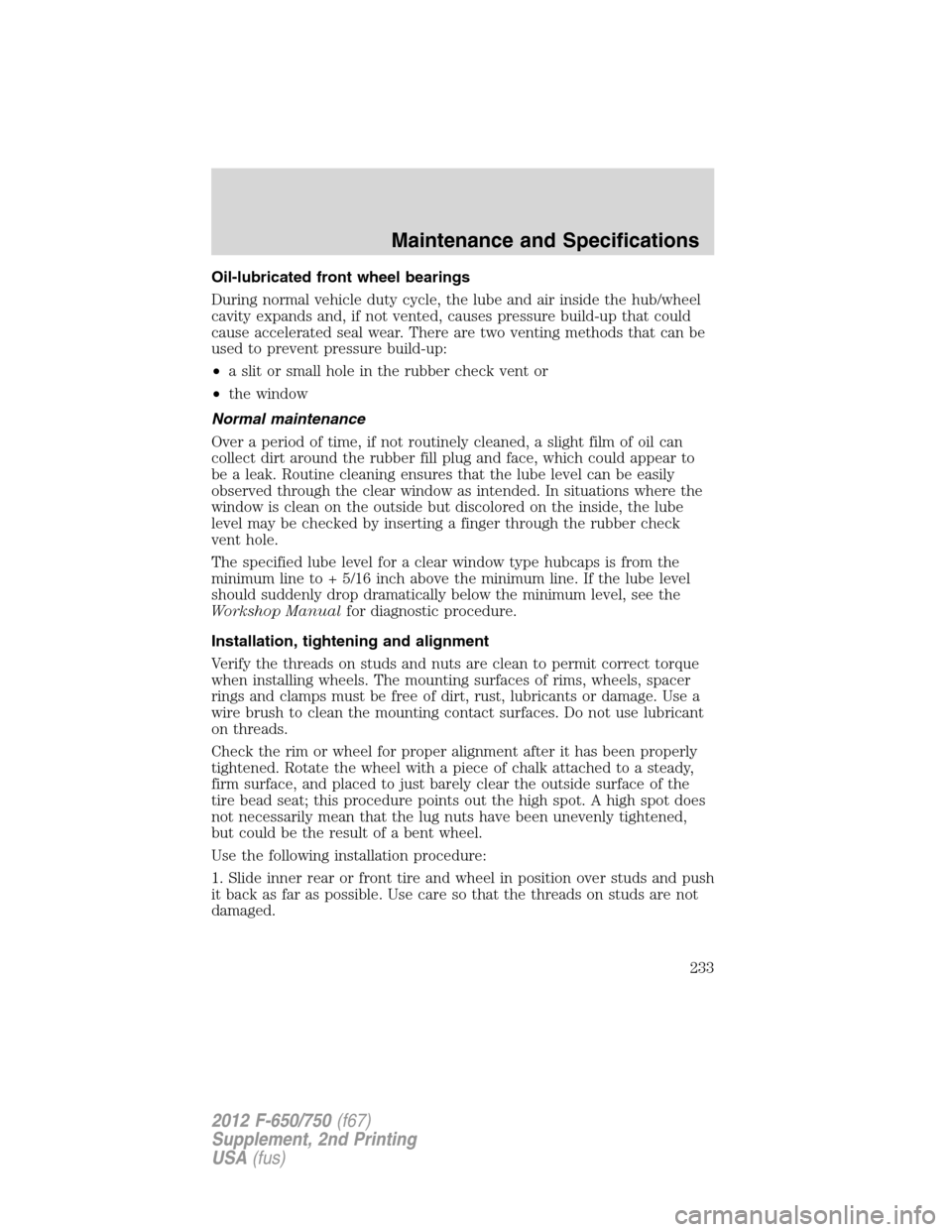2012 FORD F750 wheel alignment
[x] Cancel search: wheel alignmentPage 183 of 306

At regular intervals, or during other scheduled maintenance (tire
rotation/service, wheel bearing service, alignment, etc.), the kingpins
should be checked for excessive wear. Refer to the service manual for
proper procedures.
Toe-in setting - general inspection
Inspecting steer axle tires in the first 3,000–10,000 service miles
(5,000–16,000 service km) generally shows if tires are wearing normally.
Rapid outside shoulder wear on both tires indicates too much toe-in.
Rapid inside shoulder wear on both tires indicates too much toe-out. In
P&D-type service, left-to-right steer tire tread life differentials up to 40%
can be observed depending on routes and other variables.
Follow the tire manufacturer’s recommended cold inflation pressure for
the tire size, load range (ply rating) and steer axle loading typical for
their operation (each steer axle tire equals
1�2steer axle loading).
Special applications may warrant a setting based on experience with the
type of tire operating loads and conditions. Radial tires are more
sensitive to toe-in setting than bias ply tires. While not insensitive to
vehicle alignment, fine tuning school bus alignment to line-haul truck
standards does not drastically improve tire tread life.
It is essential that correct toe-in and tire pressure be maintained for
optimum tire wear.
Rear axle - general inspection
Make sure that the axle mounting U-bolts, attaching or mounting bolts
and nuts are securely tightened. Refer toU-bolt nut torquein this
chapter. Regularly check the rear axle for damaged, binding or worn
parts.
NoSpin Detroit Locker positive locking differential
Vehicles equipped with this type differential have the operator’s manual
supplied with the vehicle. Refer to this manual for maintenance checks.
Maintenance and Specifications
183
2012 F-650/750(f67)
Supplement, 2nd Printing
USA(fus)
Page 233 of 306

Oil-lubricated front wheel bearings
During normal vehicle duty cycle, the lube and air inside the hub/wheel
cavity expands and, if not vented, causes pressure build-up that could
cause accelerated seal wear. There are two venting methods that can be
used to prevent pressure build-up:
•a slit or small hole in the rubber check vent or
•the window
Normal maintenance
Over a period of time, if not routinely cleaned, a slight film of oil can
collect dirt around the rubber fill plug and face, which could appear to
be a leak. Routine cleaning ensures that the lube level can be easily
observed through the clear window as intended. In situations where the
window is clean on the outside but discolored on the inside, the lube
level may be checked by inserting a finger through the rubber check
vent hole.
The specified lube level for a clear window type hubcaps is from the
minimum line to + 5/16 inch above the minimum line. If the lube level
should suddenly drop dramatically below the minimum level, see the
Workshop Manualfor diagnostic procedure.
Installation, tightening and alignment
Verify the threads on studs and nuts are clean to permit correct torque
when installing wheels. The mounting surfaces of rims, wheels, spacer
rings and clamps must be free of dirt, rust, lubricants or damage. Use a
wire brush to clean the mounting contact surfaces. Do not use lubricant
on threads.
Check the rim or wheel for proper alignment after it has been properly
tightened. Rotate the wheel with a piece of chalk attached to a steady,
firm surface, and placed to just barely clear the outside surface of the
tire bead seat; this procedure points out the high spot. A high spot does
not necessarily mean that the lug nuts have been unevenly tightened,
but could be the result of a bent wheel.
Use the following installation procedure:
1. Slide inner rear or front tire and wheel in position over studs and push
it back as far as possible. Use care so that the threads on studs are not
damaged.
Maintenance and Specifications
233
2012 F-650/750(f67)
Supplement, 2nd Printing
USA(fus)
Page 243 of 306

If rib tire is used on front axle and lug or off-road type on rear axle
positions:
1.Front (Steering) Axle:Replace tires at front wheels when tread is
worn to 4/32 inch (3 mm) or less.
2.Rear Axles:Tires must be removed when the tread is worn to
2/32 inch (2 mm) or less. Tires identified with the word “re-groovable”
molded on the sidewall can be re-grooved. A minimum of 3/32 inch
(2.5 mm) of under-tread must be left at the bottom of the grooves.
Wheel and tire balancing
Out-of-round or out-of-balance wheels or tires can cause vehicle
vibration, bounce and shimmy. Replace damaged or out-of-round wheels.
Out-of-round tires and wheel assemblies can be corrected by re-clocking
the tire relative to the wheel.
The tire and wheel assembly should then be dynamically balanced.
Wear
Radial tires can exhibit three types of normal wear patterns:
1. Even
2. Erosion
3. Chamfer
Even wearis a sign that the tire is being properly used and maintained.
Erosion wearhas also been called rolling wear, channel or river wear.
Erosion wear is found more often at free rolling tires. This is an
indication that the tire is being used in a slow wearing operation. What
happens is that the belt plies are held very rigid and the tread is not
allowed to distort as it passes through the contact area. Wear only occurs
at the edge of the tread. No corrective action required. If erosion gets to
be 1/16 inch (2 mm) or more, the tire may be rotated to a drive axle.
Chamfer or shoulder wear,with tires inflated properly, is a normal
tendency of most radial tire designs. If both inside and outside shoulders
are wearing evenly around the tire, no further action is required.
Over-inflation is not effective in correcting this effect.
Tires: Irregular Wear
If irregular wear is present, check the axle alignment, tire pressure,
wheel balancing, shock and suspension component condition, and wheel
bearing end play.
This condition not only shortens tire life, but adversely affects the
handling of your vehicle, which is dangerous.
Maintenance and Specifications
243
2012 F-650/750(f67)
Supplement, 2nd Printing
USA(fus)
Page 244 of 306

Rotating tires from one wheel position to another is a way often used to
even out many types of irregular wear or to avoid it altogether. Some of
the more effective tire rotation programs are:
•Steer tires that have developed some type of irregular wear pattern
can be rotated to drive axles if rib tires are being used on all wheel
positions. Applying steer tires to a drive position often cleans them
and they can be moved back to the steer axles or run out to re-tread
stage on the rear axle.
•Another rotation possibility for fleets with rib tires in all wheel
positions is to break in the new steer tires in the drive axle positions,
then move them to steer axles. This wears away tread rubber
relatively quickly in the early life of a tire when it is most likely to
develop an unusual wear pattern.
•Drive axle tires may be placed on the other end of the same axle so
that direction of rotation is reversed. This is often helpful if a heel and
toe or alternate lug wear pattern has developed.
Irregular wear can be minimized by:
•Using the right inflation pressure for the load being carried.
•Maintaining proper front wheel alignment -especially toe-in-to
specifications.
•Maintaining proper tire and wheel balance.
•Maintaining shock absorbers and suspension components.
Use of tire chains
Refer to chain manufacturer’s recommendation for correct tire chain
usage, installation and removal.
Maintenance and Specifications
244
2012 F-650/750(f67)
Supplement, 2nd Printing
USA(fus)
Page 269 of 306

Observation Maintenance operation
Excessive engine compartment
noiseInspect the engine air induction
system (including air ducts and air
filter) for loose, damaged or
missing components
Poor steering; wandering;
excessive tire wearCheck front end alignment, inspect
the tires and tire pressure
(3)
Vibration or abnormal tire wear
indicating imbalanceBalance the wheels and the tires
Hard shifting or excessive
vibrationCheck the transmission and engine
mountings
(2)
High effort to shift; noisy
transmissionCheck and adjust transmission
controls(2)
Insufficient full-throttle power or
backfiringCheck fuel pump pressure
Radiator cap does not hold
pressureClean the cap seal and cap surface
on the radiator
Electrical power supply has
diminishedCheck the battery terminals for
corrosion
Cleaning the wiper blades with a
clean cloth and mild detergent and
washing with a cleaner does not
restore a clean wipeReplace wiper blades
Noisy or difficult to operate Lubricate body lock cylinders
Headlamp beams in wrong position
when vehicle operating loadedCheck headlamp alignment
Windshield washers do not spray
when operatedCheck windshield washer fluid
level; add fluid if required
1During maintenance and repair, protect the fuel tube and the hose
assemblies, power steering lines, and brake lines from external heat,
acids and abrasions that could damage them.
2Check for (free) linkage action and ensure that (return) spring force
is adequate to maintain pedal free play.
3Adjust, repair or replace as required with the same or equivalent
parts.
Scheduled Maintenance Guide
269
2012 F-650/750(f67)
Supplement, 2nd Printing
USA(fus)